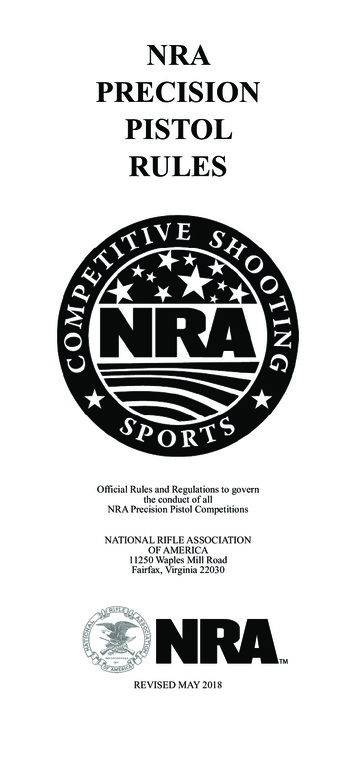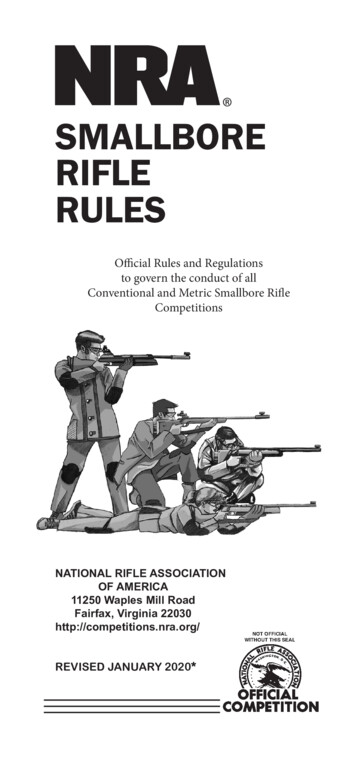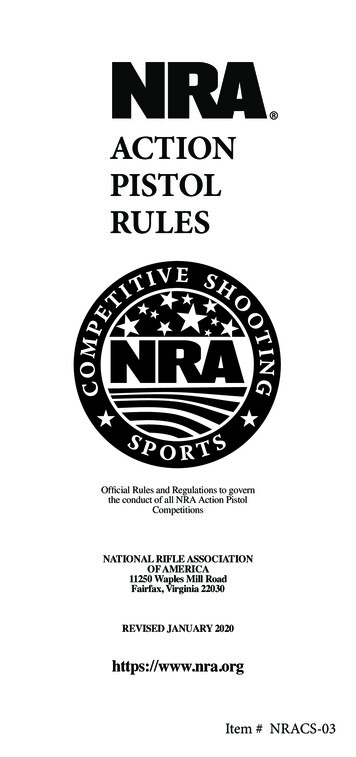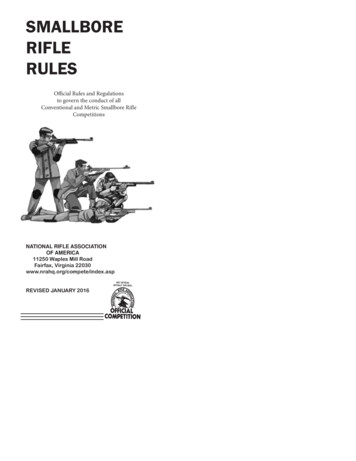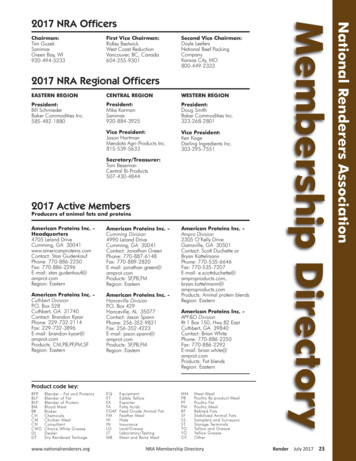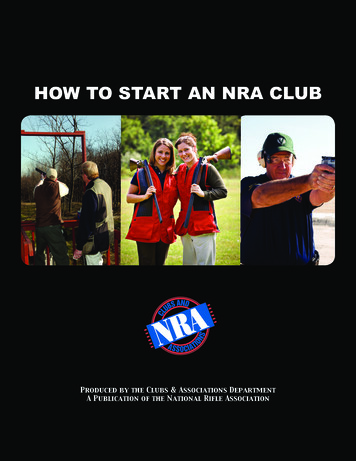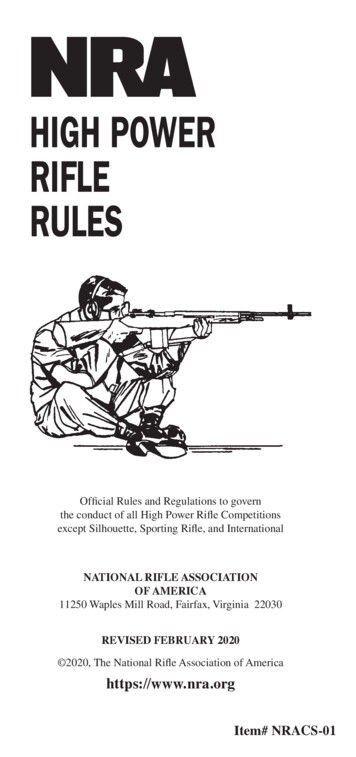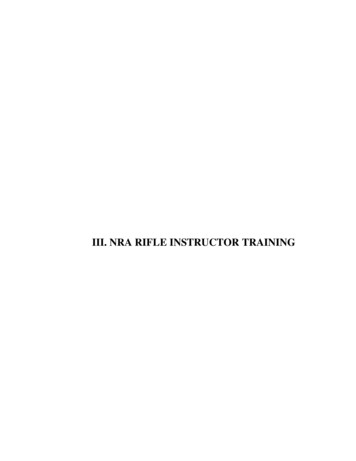
Transcription
III. NRA RIFLE INSTRUCTOR TRAINING
NRA TRAINING COUNSELOR GUIDENRA Rifle Instructor TrainingIII-2Revision date 3-16
NRA TRAINING COUNSELOR GUIDENRA Rifle Instructor TrainingNRA RIFLE INSTRUCTORTRAININGThe NRA Rifle Instructor Training Course consists of two parts: Part one: Basic Instructor Training (6 hours) Part two: NRA Rifle Instructor Training (11 hours)This chapter contains the lesson plans for part two of the NRA Rifle InstructorTraining Course. Training Counselors are encouraged to use PowerPoint presentations whenever possible.Prior to conducting the NRA Rifle Instructor Training Course, TrainingCounselors must:o Ensure candidates scored a minimum of 90% on the Basics of Rifleshooting exam.o Ensure candidates complete the pre-course questionnaire, Appendix 1.o Pass the pre-course qualification.The pre-course qualification in Appendix 3 must be conducted prior to or during thecourse. Only those candidates who achieve satisfactory scores in the pre-coursequalification, and who meet other specified requirements for NRA Rifle instructors areeligible for certification. The pre-course qualification includes the following:I.The NRA pre-course qualification will have a minimum passing score of80 out of a possible 100 points.NO LIVE AMMUNITION IN CLASSROOMIII-3Revision date 3-16
NRA TRAINING COUNSELOR GUIDENRA Rifle Instructor TrainingIII-4Revision date 3-16
NRA TRAINING COUNSELOR GUIDENRA Rifle Instructor TrainingCOURSE OUTLINENRA Rifle Instructor TrainingCourse Goal: To develop NRA Certified Instructors who possess the knowledge, skill,and attitude necessary to conduct the NRA Basic Rifle Shooting Course.Remaining Length of Course: 10 hoursCourse Lessons:Lesson VI.Introduction to NRA Basic Rifle Shooting Course Outline and LessonPlans (30 minutes)Lesson VII.Teaching Rifle Lesson I: Rifle Knowledge and Safe Gun Handling (60minutes)Lesson VIII.Teaching Rifle Lesson II: Ammunition Knowledge and the Fundamentalsof Rifle Shooting (90 minutes)Lesson IX.Basic Rifle Shooting Instructional Method (60 minutes)Lesson X.Teaching Rifle Lesson III: Firing the First Shots (90 minutes)Lesson XI.Teaching Rifle Lesson IV: Scoring Targets, and Selecting andMaintaining Your Rifle (90 minutes)Lesson XII.Evaluating and Improving Performance of Beginning Rifle Shooters (60minutes)Lesson XIII.Teaching Lesson V, Continued Opportunities for Skill Development,Using the Course Evaluation, Performance Requirements Checklist andExamination (120 minutes)NO LIVE AMMUNITION IN CLASSROOMIII-5Revision date 3-16
NRA TRAINING COUNSELOR GUIDENRA Rifle Instructor TrainingREQUIRED NRA MATERIALSNRA Rifle Instructor Training Course(Visit materials.nrahq.org for item numbers and prices.)One per candidate: NRA Trainer’s GuideNRA Basic Rifle Shooting Course Outline and Lesson Plans & ShootingNRA Guide: Basic Rifle Shooting Course Student PacketNRA Gun Safety Rules CardNRA Trainer’s ExamNRA Rifle Instructor ExamNRA Instructor Course Completion CardFor display: NRA Rifle Instructional Wall ChartsNRA Range Safety PosterSample qualification awardsIII-6Revision date 3-16
NRA TRAINING COUNSELOR GUIDENRA Rifle Instructor TrainingLesson VI:Introduction to NRA Basic Rifle ShootingOutline and Lesson PlansLearning Objectives: As a result of their participation in this training session, instructorcandidates will be able to: Describe the structure of the NRA Basic Rifle Shooting Course Outline andLesson Plans.Explain NRA policies on safety procedures, course length, required materials, andteaching methods to be followed when conducting the NRA Basic Rifle ShootingCourse.Outline the content of the NRA Basic Rifle Shooting Course.Length: 30 minutesFacility: ClassroomTraining Aids: Computer and digital projector, CD presentation disk, chalk or whiteboard, or flipchartNRA Basic Rifle Shooting Course Lesson Plans (one per candidate)NRA Guide: Basics of Rifle Shooting student handbook (one per candidate)RifleSlideIntro-1References: NRA Basic Rifle Shooting Course Outline and Lesson PlansNRA Trainer’s GuideContentA. Introduce LessonInstructional NotesState learning objectives for the current lesson.RifleB. The Structure of NRA Direct candidates to insert the NRA Basic Rifle ShootingCourse Outline and Lesson Plans into the NRA Trainer’sLesson PlansGuide binder. Explain to candidates that these lessonplans are the guidelines they are to follow in conductingthe NRA Basic Rifle Shooting Course as NRA CertifiedInstructors.III-7Revision date 3-16SlideIntro-2
NRA TRAINING COUNSELOR GUIDENRA Rifle Instructor Training1. IntroductionTurn with candidates to the Introduction in the BasicRifle Lesson Plans. Have them read pages 1 - 7 tothemselves. Highlight the following points in yourpresentation:a. BasicThe NRA Basic Rifle Shooting Course is just that: abasic course.b. Student –Instructor ratioOn the firing line a one-to-one student-to-instructor ratioon the firing line is encouraged whenever possible. If notpossible, should not exceed two-to-one.c. TPINRA courses stress hands-on learning: total participantinvolvement (TPI).d. BreaksA 10-minute break should be given after every 50minutes of instruction.e. SafetySafety must be stressed at all times, in your words and inyour actions.f. EmergenciesEmergency procedures should be established ahead oftime.g. No liveammunition inclassNo live ammunition is permitted in the practicalexercises until the live fire training on the range.h. Studentverification ofunloaded firearmsAny time you pick up a firearm, practice the three basicrules for safe gun handling: point it in a safe direction;keep your finger off the trigger; remove the ammunitionsource (if any), open the action, and visually inspect thechamber(s). Then have a student verify that the firearmis unloaded.i. Terminology forfirearmsRefer to guns as firearms, guns, Rifles, etc., but not asweapons. Weapon has a negative connotation.RifleSlideIntro-3Intro-1Rifle2. Course outlinea. Length of courseTurn with candidates to the Course Outline of the RifleLesson Plans.Note the length of the course. This is the minimum timenecessary to adequately cover the material and havestudents acquire the specified knowledge, skills, andattitude. Attainment of objectives is paramount.III-8Revision date 3-16SlideIntro-4
NRA TRAINING COUNSELOR GUIDENRA Rifle Instructor Trainingb. Course lessonsReview the structure of the course Lesson, and theLessons you will conduct to validate that training hastaken place.3. Required materialsNote that each exercise lists required materials, forexample; Firearms, eye and ear protection, performancerequirements checklist, etc.4. Learning objectivesTurn with candidates to Lesson I in the Rifle LessonPlans. Note that each Lesson begins with a list ofobjectives describing the knowledge, skills, and attitudestudents must demonstrate to verify that training hastaken place.5. TimeNote that the estimated length is indicated at thebeginning of each Lesson.6. FacilityNote that the Facility is indicated at the beginning ofeach Lesson.7. MaterialsNote that training aids are indicated for each Lesson.8. ReferencesNote that the references are indicated for each Lesson.9. Content/InstructionalNotesNote that the lesson plans have a two-column format.The left column identifies activities or content (what thestudent must learn) and the right column containsinstructional notes – how the instructor should teach thecontent to students.10. PerformanceRequirements CheckListNote the Performance Requirements Checklist inAppendix 4. Instructors complete this checklist witheach student, and retain it for their records.III-9Revision date 3-16RifleSlideIntro-5
NRA TRAINING COUNSELOR GUIDENRA Rifle Instructor TrainingC. Conclude Lesson1. SummaryAsk candidates: As a result of your participation in thislesson, can you now: Describe the structure of the NRA Basic RifleShooting Course Outline and Lesson Plans.Ask: What is the structure? RifleSlideIntro-6Explain NRA policies on safety procedures,course length, required materials, and teachingmethods to be followed when conducting an NRABasic Rifle Shooting Course.Ask: Can you give me a few examples? Outline the content of the NRA Basic RifleShooting Course.Ask: What are some examples?Rifle2. QuestionsAsk candidates what questions they have about thislesson.Answer questions.3. PreviewPreview next lesson briefly.III-10Revision date 3-16SlideIntro-7
NRA TRAINING COUNSELOR GUIDENRA Rifle Instructor TrainingLesson VII: Teaching Rifle Lesson 1: Rifle Knowledgeand Safe Gun HandlingLearning Objectives: As a result of their participation in this training session, instructorcandidates will be able to: Effectively teach the course goal and special requirements for the lessons.Effectively teach the principal parts of a rifle and the types of rifle actions, anddemonstrate how they function.Effectively explain and apply the NRA rules for safe gun handling.Effectively teach how to handle a rifle in a safe manner.Length: 90 minutesFacility: ClassroomTraining Aids: NRA Gun Safety Rules CardNRA Basic Rifle Shooting Course Outline and Lesson PlansComputer and digital projector, CD presentation disk, chalk or whiteboard, or flipchartFirearms (bolt-action, semi-Automatic, lever-action and slide-action rifles)Appropriate dummy ammunitionReferences: RifleNRA Basic Rifle Shooting Course Outline and Lesson PlansNRA Guide: Basics of Rifle Shooting handbookContentA. Introduce LessonInstructional NotesState learning objectives for the current lesson.RifleB. Practical Exercise1. IntroductionVII-2Turn with candidates to Lesson 1 in the NRA RifleLesson Plans. Review the learning objectives, Exercisecontent indicated in the left column, and methods ofinstruction on the right.Review the training aids and NRA materials to be used inteaching Lesson 1. Distribute NRA materials.III-11Revision date 3-16VII-1RifleVII-3
NRA TRAINING COUNSELOR GUIDENRA Rifle Instructor Training2. Assign topicsDivide candidates into groups. Assign each group thetask of preparing and presenting a brief training sessionon one of the following topics: Group 1, Section G-H: Types of Rifle Actions,Rifle Mechanism Knowledge Group 2, Section I-L: Explain the parts of theBolt-action, semi-automatic, lever-action, slideaction rifle knowledge Group 3, Section M: Operating Rifles.Demonstrate how to load, cock, uncock andunload bolt-action, semi-automatic, lever-action,and slide-action rifles. Group 4 Section N-O: Safe gun handling, andconduct a safe rifle handling practical exerciseExplain that there will be several practical exercisesduring the remainder of the course. All candidates mustassist in the preparation of each of their group’spresentations. All candidates will be expected to play aleading role in at least one classroom presentation andone range presentation (more, if possible).Note that their presentations will be the primary waycandidates will demonstrate that they have acquired theknowledge, skills, and attitude necessary to organize andconduct the NRA Basic Rifle Shooting Course as NRACertified Instructors.Encourage candidates to use the indicated training aidsduring their presentations.Allow time for preparation. Circulate among groups toobserve their progress. Assist when necessary byguiding candidates to solve any difficulties themselves.3. PresentationsAsk candidates to make presentations. Instruct othercandidates to observe each presentation closely and makeappropriate notes since their comments will be a primaryIII-12Revision date 3-16RifleVII-4
NRA TRAINING COUNSELOR GUIDENRA Rifle Instructor Trainingsource of input during the evaluation session to follow.Make appropriate notes on candidates’ performance.(Evaluations should be conducted immediately after eachpresentation.)4. EvaluationAsk candidates for specific comments on eachpresentation using the guidelines in the NRA TrainingCounselor Guide C5 - C6. Be sure all comments arepositive and supportive.5. ConclusionsAsk candidates how they would manage the topics timewise in an actual course, as well as what important thingsthey learned during this exercise. Share lessons youlearned in your experience in teaching Lesson I as anNRA Certified InstructorC. Conclude Lesson1. SummaryAsk candidates: As a result of your participation in thislesson, can you now:RifleVII-5 Effectively teach the course goal and specialrequirements for the lessons.Ask: What are some of the special requirements? Effectively teach the principal parts of a rifle andthe types of rifle actions, and demonstrate howthey function.Ask: What training aids would you use for this? Effectively explain and apply the NRA rules forsafe gun handlingAsk: What questions would you ask your students in thisregard? Effectively teach how to handle a rifle in a safemanner.Ask: What precautions should be used with this?2. QuestionsAsk candidates what questions they have about thislesson.Answer questions.3. PreviewPreview next lesson briefly.III-13Revision date 3-16RifleVII-6
NRA TRAINING COUNSELOR GUIDENRA Rifle Instructor TrainingIII-14Revision date 3-16
NRA TRAINING COUNSELOR GUIDENRA Rifle Instructor TrainingIII-15Revision date 3-16
NRA TRAINING COUNSELOR GUIDENRA Rifle Instructor TrainingLesson VIII: Teaching Rifle Lesson II: AmmunitionKnowledge and the Fundamentals of Rifle Shooting.Learning Objectives: As a result of their participation in this training session, instructorcandidates will be able to: Effectively teach how to identify the different components of a rifle cartridge.Effectively teach the firing sequence of cartridge.Effectively teach how to properly store ammunition.State and explain the major types of cartridge malfunctions, and teach how toreact to them.Teach the fundamentals of rifle shooting.Length: 60 minutesFacility: ClassroomTraining Aids: Computer and digital projector, CD presentation disk, chalk or whiteboard, or flipchartNRA Basic Rifle Shooting Course Outline and Lesson PlansNRA Guide: Basics of Rifle Shooting handbookFirearms (bolt-action, semi-Automatic, lever-action and slide-action rifles)Appropriate dummy ammunitionReferences: NRA Basic Rifle Shooting Lesson PlansBasics of Rifle Shooting Lesson IIPerformance Requirements Checklist Appendix 4NRA Guide: Basics of Rifle Shooting handbookContentRifleVIII-1Instructional NotesRifleA. Introduce LessonState learning objectives for the current lesson.VIII-2B. Practical Exercise1. IntroductionTurn with candidates to Lesson II in the Rifle LessonPlans. Review the learning objectives, Exercise contentindicated in the left column, and methods of instructionRifleVIII-3III-17Revision date 3-16
NRA TRAINING COUNSELOR GUIDENRA Rifle Instructor Trainingon the right.Review the training aids and NRA materials to be used inteaching Lesson II.2. Assign topicsDivide candidates into groups. Assign each group thetask of preparing and presenting a brief training sessionon one of the following topics: All Groups, Section D: Each candidate willconduct an eye dominance exercise. Group 1, Section B: Rifle ammunition. Explainand demonstrate the components of a riflecartridge, rimfire vs. centerfire, firing sequence,cartridge designations, storing ammunition, andcartridge malfunctions, using groups 2, and 3 asbasic students. Group 2, Section C and E: Review safe gunhandling rules, and demonstrate position. Group 3, Section G: Demonstrate thefundamentals of rifle shooting. Aiming, holdcontrol, breath control, trigger control and followthrough.You may wish to assign two topics to a group.Encourage candidates to use the indicated training aidsduring their presentations.Allow time for preparation. Circulate among groups toobserve their progress. Assist when necessary byguiding candidates to solve any difficulties themselves.3. PresentationsAsk candidates to make presentations. Instruct othercandidates to observe each presentation closely and makeappropriate notes since their comments will be a primarysource of input during the evaluation session to follow.Make appropriate notes on candidates’ performance.(Evaluations should be conducted immediately after eachpresentation.)III-18Revision date 3-16RifleVIII-4
NRA TRAINING COUNSELOR GUIDENRA Rifle Instructor Training4.EvaluationAsk candidates for specific comments on eachpresentation using the guidelines in the NRA TrainingCounselor Guide, C5 – C6. Be sure all comments arepositive and supportive.5.ConclusionsAsk candidates how they would manage the topics timewise in an actual course, as well as what important thingsthey learned during this exercise. Share lessons youlearned in your experience in teaching Lesson II as anNRA Certified InstructorC. Conclude LessonRifle1. SummaryAsk candidates: As a result of your participation in thislesson, can you now: VIII-5Effectively teach how to identify the differentcomponents of a rifle cartridge.Ask: What training aids will you need for this exercise? Effectively teach the firing sequence of cartridge.Ask: Where in the handbook can a student see this? Effectively teach how to properly storeammunition.Ask: Where in the handbook can a student see this? State and explain the major types of cartridgemalfunctions, and teach how to react to them.Ask: What should be stressed to students on squib loads? Teach the fundamentals of rifle shooting.Ask: What are the five fundamentals of rifle shooting?2. QuestionsAsk candidates what questions they have about thislesson.Answer questions.3. PreviewPreview next lesson briefly.III-19Revision date 3-16RifleVIII-6
NRA TRAINING COUNSELOR GUIDENRA Rifle Instructor TrainingIII-20Revision date 3-16
NRA TRAINING COUNSELOR GUIDENRA Rifle Instructor TrainingLesson IX:Basic Rifle Shooting Instructional MethodLearning Objectives: As a result of their participation in this training session, instructorcandidates will be able to: Explain the importance of concentration for the success of beginning rifleshooters.List various ways the instructor can enhance the students’ ability to concentrate.Describe the NRA eight-step method for training beginning rifle shooters.Describe the coach/pupil method, ball and dummy technique, and explain thevalue of using them in the training process.Length: 60 minutesFacility: ClassroomTraining Aids: Computer and digital projector, CD presentation disk, chalk or whiteboard, or flipchartFirearms (bolt-action, semi-Automatic, lever-action and slide-action rifles)Appropriate dummy ammunitionRifleReferences: NRA Basic Rifle Lesson Plans Appendix 2: The Fundamentals of Rifleshooting.III-21Revision date 3-16IX-1
NRA TRAINING COUNSELOR GUIDENRA Rifle Instructor TrainingContentA. Introduce LessonInstructional NotesState learning objectives for the current lesson.RifleIX-2B. Concentration1. ImportanceAsk candidates, excluding safety, what the mostimportant element essential to the success ofbeginning rifle shooters is? Discuss responses.Identify concentration as the element.RifleIX-3RifleIX-42. DefinitionAsk candidates what concentration is? Discussresponses briefly.Explain that it is the ability to focus all one’sattention and energies on the accomplishment of aspecific task.3. Implications for instructorAsk candidates since concentration is soimportant to the success of beginning shooters,what implication does this have for the instructor?Discuss responses.Explain that everything the instructor does mustbe directed toward enhancing the shooters’ abilityto concentrate.4. Ways to enhance concentrationHave candidates turn to Appendix 3 Section D.Ask candidates what ways the instructor cana. Small caliber ammunition for enhance the students’ ability to concentrate?less recoil (.22 standardDiscuss responses.velocity)Identify appropriate responses in yourb. Proper grip sizepresentation, including those listed at left.c. Manageable gun weight (butnot too light)d. Medium barrel lengthe. Gun functional andmechanism cleanf. Good quality ammunitionIII-22Revision date ifleIX-10
NRA TRAINING COUNSELOR GUIDENRA Rifle Instructor Trainingg. Target close to shooterh. Target relatively largei. Target blankj. Good lightingk. Fair weatherl. Little windRiflem. Comfortable clothingIX-11n. Instructor does not overinstructo. Adequate ear and eyeprotectionp. Avoid or control backgroundnoiseq. Keep spectators to aminimumr. Stress fun as opposed tocompetition5. Object of concentrationAsk candidates what beginning rifle shootersshould concentrate on to ensure success? Discussresponses.Explain that the students must learn toconcentrate on the two most importantfundamentals: aiming and trigger control, withthe visual focus on the front sight. The studentsmust learn to watch the front sight whilesqueezing the trigger straight to the rear in asmooth, continuous manner without disturbing thesight alignment. All other factors are secondary.Remind instructors that they will need to stressand reinforce this point regularly.III-23Revision date 3-16RifleIX-12
NRA TRAINING COUNSELOR GUIDENRA Rifle Instructor TrainingC. Rifle Instructional MethodTurn with candidates to Lesson III, section C ofthe Rifle Lesson Plans. Explain that the NRA hasdeveloped an eight-step method for teachingbeginning rifle shooters. Following the principlesof total participant involvement, the method hasthe students perform a different activity in eachstep.Stress that this method, along with the emphasison concentration, was developed with the goal ofensuring initial success in beginning rifleshooters. Success encourages and motivates thestudents, ensures an enjoyable learningexperience, and provides reinforcement to thetraining process.1. Study the positionThis involves students by having them read, hear,and/or see the elements of a good shootingposition.2. Practice position without gunThis has students practice what they have justheard and seen. The gun is not yet used so thestudents can concentrate totally on the position ofthe body.3. Practice position with gunOnce the students have achieved a good bodyposition, the gun is added. The gun fits theposition, not the other way around.4. Align position with targetThere are different techniques for aligning eachposition. Natural aiming area is stressed.Note that the first four steps are concerned withputting the students into the correct position.5. Dry fire exerciseAsk candidates what the advantages of dry firingas an instructional technique are? Discussresponses, including the following: It allows the students to concentrate ontechnique rather than result. It allows the students to refine skillsbefore live firing, increasing the likelihoodof success.III-24Revision date 3-16RifleIX-13
NRA TRAINING COUNSELOR GUIDENRA Rifle Instructor Training It makes it easier for the instructor toobserve and provide feedback on thestudents’ technique.6. Live fire exercisesStudents fire for group size (not score) at a large,relatively close, blank target, loading one shot at atime. The instructor observes and providesappropriate feedback. Afterward, studentsparticipate in a five-shot exercise to shoot agroup.7. Make appropriate sightadjustmentsStudents are taught to make sight adjustmentsfrom the benchrest position.8. Resume live firingLive firing is resumed, this time on a bullseyetarget, so students can learn the importance ofproper sight picture. Afterward, the studentsrepeat the first six steps when learning othershooting positions. It is extremely important thatstudents learn to shoot a group, and then move itto the center of the target.D. Instructional TechniquesAsk candidates what is the coach/pupil method?What is the ball and dummy technique?Rifle1. Coach/pupil methodTurn with candidates to Appendix 3, page A3-4section III, sub-section B.IX-14RifleIX-15a. ExplanationExplain the coach/pupil method: an instructionaltechnique that pairs two students who alternatelyplay the roles of coach and pupil under thesupervision of an instructor. A single gun is usedfor the two students. The “pupil” shoots while the“coach” provides instruction, support, andfeedback under the direction of the instructor.The “coach” and “pupil” then reverse roles.Following the principles of total participantinvolvement, this method involves the people whoare waiting for a turn to shoot (the “coaches”) inthe learning process of those who are actuallyshooting (the “pupils”). The “coaches” becomemore keenly aware of what they have learned byarticulating and communicating it to anotherIII-25Revision date 3-16
NRA TRAINING COUNSELOR GUIDENRA Rifle Instructor Trainingstudent. This also reinforces learning for “pupils”and “coaches” alike.Note that the coach/pupil method should be usedwhenever possible throughout the eight steps ofthe NRA instructional method for teachingbeginning rifle shooters on the range.b. DemonstrationChoose two candidates to demonstrate thecoach/pupil method. Appoint one to be the“coach,” the other the “pupil.” Have them cometo the front of the room. Instruct the “coach” toassist the “pupil” in assuming the benchrestshooting position. Note that even though it wasnot the “coach’s” turn to shoot, the “coach”actively participated and became involved in thelearning experience of the “pupil” under theguidance and direction of the instructor.Note also that this method provides increasedattention to safety because there is an additionalperson watching the shooter.2. Ball and dummy techniqueTurn with candidates to Appendix 3 page A3-7section exercise three. Explain the ball anddummy technique: an instructional technique inwhich a student fires a gun whose condition(loaded or unloaded) is known to the instructorbut not the student.Ask candidates what they think the purpose ofthis technique is? Discuss responses.Explain that it allows both the student and theinstructor to see clearly what the student is doingwhen the student believes there is a live round inthe chamber. This helps the student concentrateon technique and reinforces correct skillsexecution.Note that the ball and dummy technique may beused at the discretion of the instructor during thelive fire portion of the range exercises in the NRABasic Rifle Shooting Course.III-26Revision date 3-16
NRA TRAINING COUNSELOR GUIDENRA Rifle Instructor TrainingE. Conclude Lesson1. SummaryAsk candidates: As a result of your participationin this lesson, can you now: Explain the importance of concentrationfor the success of beginning rifle shooters.Ask: What is the importance of concentration? List various ways the instructor canenhance the students’ ability toconcentrate.Ask: What are some examples of how to do this? Describe the NRA eight-step method fortraining beginning rifle shooters.Ask: What are the steps? Describe the coach/pupil method and balland dummy technique, and explain thevalue of using them in the trainingprocess.Ask: What is the value of using these techniques?2. QuestionsAsk candidates what questions they have aboutthis lesson.Answer questions.3. PreviewPreview next lesson briefly.III-27Revision date 3-16RifleIX-17
NRA TRAINING COUNSELOR GUIDENRA Rifle Instructor TrainingIII-28Revision date 3-16
NRA TRAINING COUNSELOR GUIDENRA Rifle Instructor TrainingLesson X:Teaching Rifle Lesson III: Firing the FirstShotsLearning Objectives: As a result of their participation in this training session, instructorcandidates will be able to: Effectively teach the knowledge, skills and attitude necessary to assume thebenchrest position with a rifle.Effectively teach how safely shoot a rifle from the benchrest position, using thefundaments of rifle shooting, at a target on a range.Effectively demonstrate the knowledge, skills and attitude necessary to assumethe free arm and arm rest standing shooting positions with a rifle.Effectively teach how to safely shoot a rifle from the free arm and arm reststanding shooting position, using the fundamentals of rifle shooting, at a target ona range.Length: 90 minutesFacility: RangeTraining Aids: NRA Basic Rifle Shooting Course Outline and Lesson PlansNRA Guide: Basics of Rifle Shooting handbookFirearms, ammunitionAppropriate dummy ammunitionSafety glasses, hearing protectionTargetsSandbags, benches (tables), and chairsSight adjustment toolsReferences:Rifle X-1NRA Basic Rifle Lesson Plan , Lesson IIIIII-29Revision date 3-16
NRA TRAINING COUNSELOR GUIDENRA Rifle Instructor TrainingContentInstructional NotesRifleA. Introduce LessonState learning objectives for the current lesson.X-2B. Practical ExerciseBe sure to emphasize that candidates acting asstudents should not shoot like a professional! BESTUDENTS!1. IntroductionTurn with candidates to Lesson III in the Rifle LessonPlans. Review the learning objectives, Exercise contentindicated in the left column, and methods of instructionon the right.2. Assign topicsReview the training aids and NRA materials to be used inteaching Lesson III.RifleX-3RifleX-4Divide candidates into two groups. Assign each groupthe task of preparing and presenting a brief trainingsession on one of the following topics. Each groupmember will need to teach another group member howshoot using the NRA 8-step instructional method. Training Counselor will conduct a range safetybrief using the NRA Rifle Lesson plans. Group 1, Section C: Firing the First Shots. UsingGroup 2 as students, Group 1 will teach the 8 stepmethod for shooting a rifle from a benchrestposition. Group 2, Section D: Free Arm Standing position.Using Group 3 as students, Group 2 will teach the8 step method for shooting a rifle from a FreeArm standing position. Group 3, Section E: Arm Rest Standing position.Using Group 1 as students, Group 2 will teach the8 step method for shooting a rifle from Arm Reststanding position.Allow time for preparation. Circulate among groups toobserve their progress. Assist when necessary byguiding candidates to solve any difficulties themselves.III-30Revision date 3-16
NRA TRAINING COUNSELOR GUIDENRA Rifle Instructor Training3. PresentationsAsk candidat
NRA TRAINING COUNSELOR GUIDE NRA Rifle Instructor Training Revision date 3-16 III-13 4. Evaluation 5. Conclusions C. Conclude Lesson 1. Summary requirements for the lessons. 2. Questions 3. Preview source of input during the evaluation session to follow. Make appropriate notes on candidates' performance.
